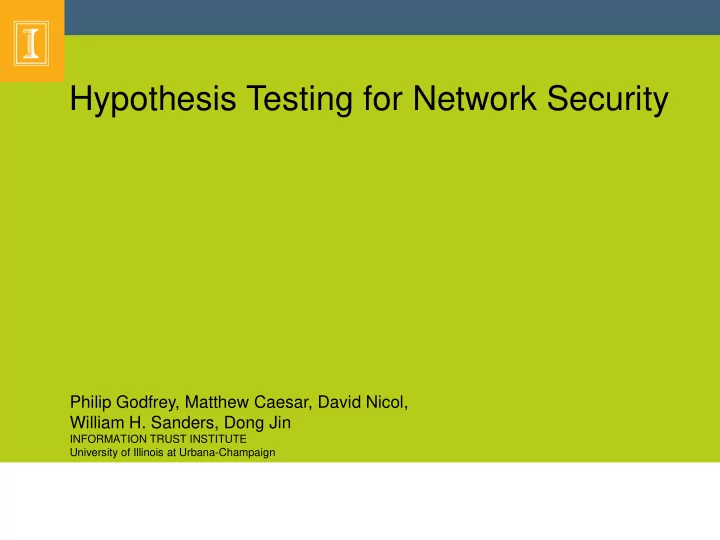

Hypothesis Testing for Network Security Philip Godfrey, Matthew Caesar, David Nicol, William H. Sanders, Dong Jin INFORMATION TRUST INSTITUTE University of Illinois at Urbana-Champaign
We need a science of security • Practice of doing cyber-security research needs to change – Attempts based on reaction to known/imagined threats – Too often applied in ad-hoc fashion • SoS program: move security research beyond ad-hoc reactions – Need a principled and rigorous framework – Need a scientific approach 2
What is science? sci·ence noun \ ˈsī - ən (t)s\ : the systematic study of the structure and behavior of the natural and physical world through observation and experiment The scientific method 1. Ask a question 2. Formulate a hypothesis 3. Design and conduct an experiment 4. Analyze results 3
Towards a science of security • Can we apply the scientific method to the domain of cybersecurity? – Challenges: complex, large scale+dynamic environments, many protocols/mechanisms – Opportunities: isolation, rigorous analyses, formal models, automation • Can we develop a methodology for science of security? 4
Our work • NetHTM: a methodology for science of security – Techniques for performing/integrating security analyses to rigorously answer hypotheses about end to end security of a network • Core: hypothesis evaluation engine – Input: testable hypotheses, formal model of system – Automatically designs and conducts experiments to evaluate veracity of hypotheses • Our focus: Network data flow security – Builds upon our prior work in formal network modeling 5
Overall System Architecture Security Scientist Hypotheses • “All network paths traverse a firewall” “Fraction of CRE vulnerabilities in • network, given set of deployed ACLs, is less than 1%” NetHTM Hypothesis Testing Platform System under evaluation Results 6
Active sub-tasks and Status • Task 1: Methodologies for modeling and analyzing networks – Core Network Model – Modeling virtualized networks [best paper award, HotSDN 2014] • Task 2: Automated techniques for hypothesis testing – Automated experiment construction algorithm – Database model of network behavior • Task 3: Realizing a practical system – Modeling dynamic behaviors [NSDI 2015] 7
Let’s start with a router Configuration Control Plane Data Plane Network Forwarding 8
One approach: Build a model of the router Input • Pros: Configuration – Can test prior to deployment • Cons: Control Plane – Modeling is complex – Prediction Data Plane Predicted misses bugs in control plane – Requires vendor Network support Forwarding 9
Our approach: Just model the data plane Configuration • Pros: – Checks as close as possible to network Control Plane behavior – Unified analysis for multiple Data Plane Input protocols – Catches implementation Network bugs Predicted Forwarding 10
Our approach: Data-plane modeling • Challenge: need some general way to express complex forwarding behavior • Solution: Represent data plane as boolean functions – Can leverage well-understood approaches to SAT solving, to check hypotheses against data plane – Translate SAT results to report hypothesis veracity along with diagnostic information 11
Examples Packet Filtering Longest Prefix Matching Destination Interface Destination Interface 10.1.1.0/24 v 10.1.1.0/24 v 10.1.1.128/25 w Drop port 80 to v v v u u w Similar approaches to handle NAT, multicast, ACLs, encapsulation, MPLS label swapping, OpenFlow, etc. P(u,v) = IP dest ∈ 10.1.1.0/24 P(u,v) = IP dest ∈ 10.1.1.0/24 ^ IP dest ∉ 10.1.1.128/25 ^ Port dest ≠ 80 12
Automating Hypothesis Testing • Could directly extend existing techniques (e.g., SAT solvers) – Problem: not very scalable • Alternative solution: represent and test Boolean functions as graph traversals • Main idea: – Represent network state as a forwarding graph – Translate hypothesis tests into graph traversals 13
Limiting the Search Space Hypothesis Testing Engine Equivalence class: Packets experiencing Generate the same forwarding Updates Equivalence Classes actions throughout the network. 64.0.0.0/3 0.0.0.0/1 Fwd’ing rules 0.0.0.0/0 Equiv. classes 1 2 3 4 14
Limiting the Search Space Hypothesis Testing Engine Generate Generate Updates Equivalence Forwarding Classes Graphs Forwarding All the info to answer hypotheses graphs: 15
Limiting the Search Space Hypothesis Testing Engine Generate Generate Updates Equivalence Forwarding Run Experiments Classes Graphs Incorrect Correct Hypotheses Hypotheses Black holes, Result report Routing loops, • Experimental step Isolation of multiple VLANs, that violates Access control policies hypothesis • Affected set of packets 16
Evaluation • Simulated an IP network using a Rocketfuel topology – Replayed Route Views BGP traces – 172 routers, 90K BGP updates – Microbenchmarked each phase of HTE’s operation 17
Single-Hypothesis Testing Speed 97.8% of experiments concluded within 1 millisecond 18
Dealing with System Dynamics • Challenge: Networks are Dynamic and Nondeterministic – May not always know what will happen given an input – May not always have up to date state – May not be fully deployed • Solution approach: dealing with “uncertainty” – Explicitly model uncertainty in network’s current state 19
Motivating example Case 1: update ? B C S2 S1 [nh=D received I want to shift Should I send B traffic from S1 Case 2: update not ? B C S2 [nh=C] now? S1 to S2. yet received Change your next hop Change your next hop Controller to S2 to C nh=S2 nh=C B C 20 S1 S2
Uncertainty-aware modeling: Approach “uncertain” links “certain” links 1. Derive possible network states, given inputs 2. Represent possible states using symbolic “uncertainty graph” 3. Traverse graph to test hypotheses 4. Update graph as information comes in 21 Network changes, acks from network, certain delays pass –
Technical approach Controller GCC Network Model Update Update Pass Pending Updates Stream of Analysis Updates Update Engine Network Confirm Fail 22
Hypothesis Testing Time in Dynamic Networks 80% of the hypotheses tested within 10 microseconds 23
Conclusion • We are constructing a hypothesis testing engine for SoS – Analysis methodology for reasoning about science of security of networks – Adds to theoretical underpinnings of SoS, supports practice of SoS • Early results indicate feasibility – Experiments run in milliseconds on complex networks • Interested in working with you – My contact info: caesar@illinois.edu 24
Recommend
More recommend